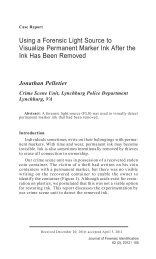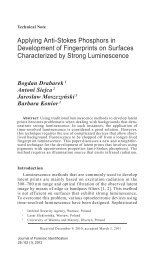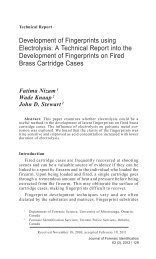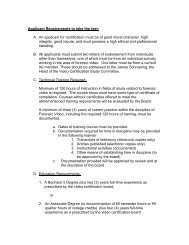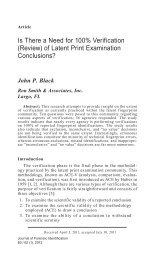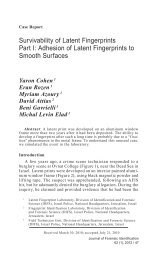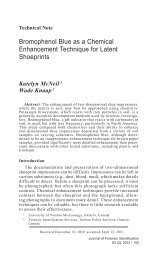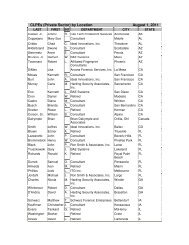Individualization Using Friction Skin Impressions: Scientifically ...
Individualization Using Friction Skin Impressions: Scientifically ...
Individualization Using Friction Skin Impressions: Scientifically ...
Create successful ePaper yourself
Turn your PDF publications into a flip-book with our unique Google optimized e-Paper software.
publication through multiple and various professional literature<br />
sources since the late 1600s. Additionally, the theory explaining<br />
the cause for this observed uniqueness has been tested using<br />
various methods both empirically and probabilistically beginning<br />
in the late 1800s. Furthermore, the science of friction<br />
ridge skin examination itself, of reliably applying the science,<br />
has been empirically demonstrated as well over the course of<br />
a century. Lastly, regarding the question of general acceptance,<br />
attempts are still made today to argue that the science<br />
of friction ridge skin examination is not generally accepted<br />
[41, 42] on the basis of the 2009 report by the NRC entitled<br />
Strengthening Forensic Science in the United States: A Path<br />
Forward [43]. These claims of lacking general acceptance are<br />
made without a basis. The science and application of the science<br />
is well accepted in the medical community, the forensic community,<br />
and the legal community. The science of friction ridge<br />
skin identification is used not only in the forensic discipline<br />
worldwide, but also in cases of identifying victims of natural<br />
disasters and in security verification systems both in government<br />
and in the private sector. Although the 2009 NRC report<br />
did indicate general areas where the forensic discipline could<br />
improve (addressing all areas of the forensic sciences) in accordance<br />
to their Congressional charge to “make recommendations<br />
for maximizing the use of forensic technologies and techniques<br />
to solve crimes, investigate deaths, and protect the public”, one<br />
of the 13 recommendations was, “Congress should authorize<br />
and appropriate funds . . . to launch a new broad-based effort to<br />
achieve nationwide fingerprint data interoperability . . . which<br />
could result in more solved crimes . . . and greater efficiency<br />
with respect to fingerprint searches.” [43] Such a recommendation<br />
by the NRC, representative of the highly respected general<br />
scientific community, is hardly one of lacking acceptance of the<br />
science of friction ridge skin examination. This statement of<br />
general acceptance is supported not only by the NRC in 2009,<br />
but also by its predecessors in 1992 and 1996. In 1992, the<br />
NRC, in its report on DNA evidence, stated, “Fingerprints were<br />
described as an individualizing characteristic as early as 1892 . .<br />
. minutiae in the fingerprint patterns, not ridge counts, are used<br />
for personal identification. The minutiae result from nongenetic<br />
events during embryonic development...” [2]. In 1996, when<br />
comparing DNA with friction ridge skin, a second NRC report<br />
states, “DNA analysis promises to be the most important tool for<br />
human identification since Francis Galton developed the use of<br />
fingerprints for that purpose. We can confidently predict that,<br />
Journal of Forensic Identification<br />
62 (1), 2012 \ 73



